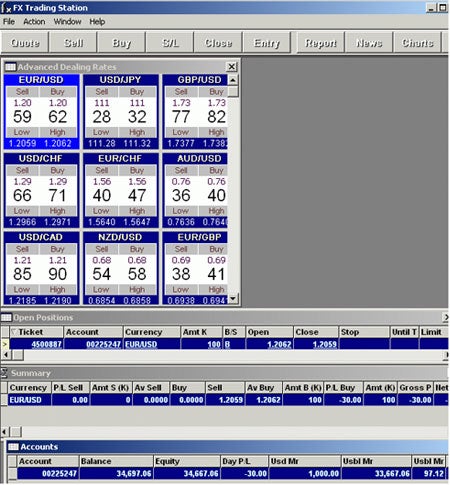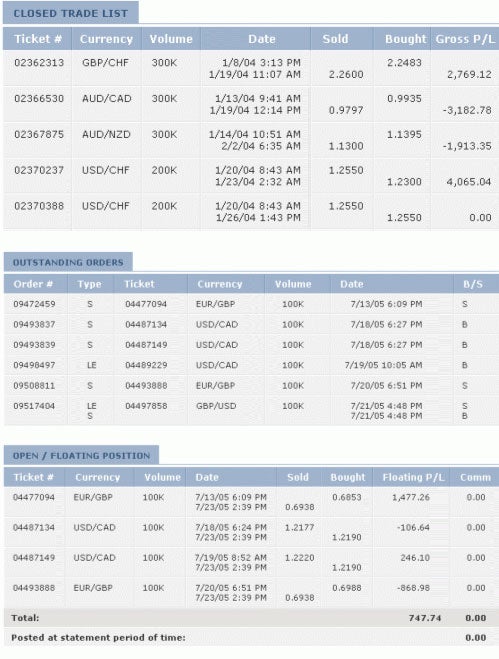By Zhuge Liang
PLEASE read 1st part ==> Forex - FX >>>>> What Does Forex - FX Mean?
Forex: Demo Before You Dive In
Because forex (FX) is a decentralized market in which dealers disseminate their own price feeds through proprietary trading platforms, it is crucial to learn the features and idiosyncrasies of each type of trading software before committing real funds to an account. Fortunately, in retail, FX traders can test out each platform using demo dollars. Every reputable dealer in FX allows potential customers to download a free demo version of its software. This is critical if the customer is to become acquainted with the platform's layout and the means of order entry. Here we'll discuss the importance of demo trading and let you know what you should look out for when trying different platforms.
Basic vs Integrated Platforms
Looking at the following screen images, you can see how some platforms integrate everything from charting to news, while others have very simple layouts that focus only on price quotes, order entry and reporting.
Because forex (FX) is a decentralized market in which dealers disseminate their own price feeds through proprietary trading platforms, it is crucial to learn the features and idiosyncrasies of each type of trading software before committing real funds to an account. Fortunately, in retail, FX traders can test out each platform using demo dollars. Every reputable dealer in FX allows potential customers to download a free demo version of its software. This is critical if the customer is to become acquainted with the platform's layout and the means of order entry. Here we'll discuss the importance of demo trading and let you know what you should look out for when trying different platforms.
Basic vs Integrated Platforms
Looking at the following screen images, you can see how some platforms integrate everything from charting to news, while others have very simple layouts that focus only on price quotes, order entry and reporting.

Figure 1 - A very straightforward platform from FXCM. The primary focus is on execution - quotes, positions and account balances are all clearly marked and visible
Figure 2 - A more integrated platform from Oanda that tries to combine quotes, charts and account balances all on one screen.
Figure 3 - Another integrated platform, this time from FX Solutions, that squeezes a trade summary, quotes and market news headlines all into one screen.
Placing Orders
As a trader, you should always try out dealer demos before trading live - it's the only way to become familiar with the different features of various platforms. For example, some platforms simply use pop-up tickets, while others actually mark the order location on the chart. Typically, to buy a currency pair you simply click on the offer part of the quote (the ask), and to sell, you click on the bid part. Some platforms allow you to choose market or limit orders after the quote window pops up, while others force you to make your selection beforehand.
It's a good idea to place at least 20 demo trades on each platform before trading actual money, just so you can master the specifics of order entry on each platform. A trader should never trade live unless he or she can confidently answer all of the following questions:
1.How do I place a limit order?
2.How do I set a stop?
3.Can I set a limit and a stop at the time of entry?
4.Are the spreads on the platform fixed or variable?
5.What is the lot size that I can trade (1,000 units, 10,000 units, 100,000 units)?
6.Can I mix and match the lot sizes?
7.Can I call the dealing room directly if my internet connection goes down?
Figure 4 - A simple market order ticket on the FX Solutions platform that clearly shows that the user is selling 1 lot of GBP/USD
Figure 5 - An example of an order ticket on the FXCM platform that allows the trader to attach stop and limit parameters to a market buy order of EUR/USD.
Figure 6 - From the Oanda platform, a limit order in EUR/USD that quotes all the way to five decimal places (i.e. 1/1000th of a penny!) and automatically makes the order good for a week.
The Taxman Cometh
One function that most new FX traders overlook is tax reporting. Because FX is a global, unregulated market, dealers as a general rule do not provide any documentation to the tax authorities in the trader's country of residence. Tax reporting is solely the responsibility of the trader. Dealers simply produce detailed transaction histories - in an electronic format - from which the traders must then compile their own tax reports. Such an arrangement clearly calls for a trading platform with highly organized and flexible reporting functions. But reporting quality varies greatly from dealer to dealer: all dealers will provide you with a full transaction report, but how those transactions are laid out could mean the difference between spending hundreds of hours on reconciliation or taking one minute to print out a final report to present to your accountant. Note the different approaches to reporting in the following platforms:

Figures 7 and 8 - Note how the FXCM platform elegantly separates closed trades, outstanding orders and floating positions and then tidily summarizes all the key activity in an account summary.
Figure 9 - The Oanda platform requires the trader to do his/her own trade reconciliation.
Some FX traders may generate as many as 1,000 trades in a year. A platform that reconciles all those trades into an easy-to-understand, end-of-year income statement, breaking down all profits and expenses, can be invaluable. Reporting, though hardly the glamorous part of FX trading, is a crucial part of a trader's personal record keeping and can have significant tax ramifications.
Tax treatment of currency trading is very much dependent on the individual's tax status. Most dealers will not advise you regarding tax matters, nor should you take their advice if they do, because they lack the expertise to deal with the multitude of tax authorities around the world. You should always consult with a tax professional before choosing a course of action.
A final note on taxes and reporting: as you try out the various dealers' platforms, you will find that certain functions are common across most software. The devil is in the details, which can determine the difference between profits and losses.
Trade Like It's Real
Once you have mastered the mechanics, you can use the demo platform to experiment with various trade sizes and styles and determine your trading personality. Are you a short-term momentum trader who likes high leverage and tries to capture 20-30 point intraday moves? Or do you prefer using smaller sizes to hold longer-term positions that could potentially yield hundreds of points? Demo trading can help you discover what type of trading suits you best.
Always remember, however, that demo trading is in no way similar to trading real money. You may be perfectly calm about sustaining a $10-million loss with fake money, but might become completely unhinged over a $100 loss in your real account. To make demo trading as productive as possible, you need to trade the demo account as though the money were real. For example, if you plan on funding your real account with $5,000, don't trade a demo account that has $100,000. The thrill of a $1-million trade can give you a temporary high, but it will only hurt when you have to transition to a real account, because you will have no sense of proportion and will likely make drastic errors in judgment.
Conclusion
Even after you decide to trade live, demo trading can be very valuable. Many successful traders will test strategies and set-ups on practice accounts before they try them out with real money. Although demo trading will not guarantee you profits in real life, almost all traders agree that if you cannot first achieve success on a demo, you are almost certain to fail in your live account. This is why demo trading is vital to the growth and development of all FX traders.
===> Click
BACK TO CHAT BOX
.png)



No comments:
Post a Comment